-

新人教版高中英语必修2Unit 4 History and Traditions-Listening&Speaking&Talking教案二
Listening and Speaking introduces the topic of “Take part in a youth project”. The listening text is an interview about "sharing views on historical sites". Through listening to a dialogue between Chinese and foreign students on the way to the Confucius Temple, students can understand their views on the Confucius Temple, Confucius, Confucius' descendants and Confucius' educational thoughts, so as to realize and think about the profound influence of Confucius and his thoughts on Chinese historical tradition. At the same time, the dialogue naturally integrates English idioms and mentions Shakespeare, the British playwright, so as to provide language materials and context for students to understand English idioms and related cultural allusions, as well as to compare Chinese and foreign cultures, which is helpful for students to understand and express the language such as history, tradition, culture and custom significant impact.Text analysis: listening text is a dialogue between a British student and a Chinese student when he goes to the Confucius Temple. When William, a British student, visited the Confucius Temple, he asked Xiao Kong, a Chinese student, for directions. Xiao Kong was just going to the Confucius Temple to meet with the members of the research group, so they went together and exchanged their views on the Confucius Temple, Confucius, Confucius' descendants and Confucius' educational thoughts. From the perspective of foreign tourists, this paper describes their thoughts on Confucius, the great son of Confucius, who had a profound impact on Chinese history and cultural tradition, and his education.Listening and Talking introduces a visit to a historic tourist destination. Tourism is a common way to understand a country's history, culture, and customs and so on. Students listen to the dialogue between Xiao Yan, a youth hostel Usher, and Paul, a backpacker, to learn about Pingyao's famous historical and cultural attractions and Paul's travel experience and experience as a foreign tourist.

新人教版高中英语必修2Unit 5 Music-Discovering Useful Structures教案二
4. When he got absorbed in his world of music, he felt as if he could “see” the beauty of the world around him, like he had in his previous life.P·P as adverbial: _________________________________________________________________.Function: _______________________________________________________________________.Step 5 Solid Complete the passage with the words in brackets in their correct forms.Well known as a successful band, the Impact members show quite a few striking qualities. They never ever give up. When _____________(question) by the media, they are not _____________(discourage) and practise even harder. They are improving themselves by attending several master training class. They are united. _____________(fill with) team spirit, they act as a whole, always aiming for glory. Step 6 Difference and similarity from -ingObserve the following examples.1. He went out, shutting the door behind him.=He went out, ________________________________________________________.2. Not knowing what to do, he went to his parents for help.=__________________________________________, he went to his parents for help.Similarity: _______________________________________________________________________________________________________________________________________________________.Difference : _______________________________________________________________________________________________________________________________________________________.Step Practice1. ________ in a hurry, this article was not so good. 因为写得匆忙, 这篇文章不是很好。2. ________ carefully, he found something he hadn’t known before. 他仔细读书时, 发现了一些从前不知道的东西。3. ________ why he did it, the monitor said it was his duty. 当被问及他为什么要这么做时, 班长说这是他的职责

新人教版高中英语必修2Unit 5 Music-Reading and Thinking教案二
1. Get basic information about Eric; read deeply to understand the history and development of the virtual choir.2. Understand what the function of the virtual choir is and how to make a virtual choir.3. Understand the meaning of some languages in the context of the text through question guidance, such as “Many people do not have close friends or contacts who have the same interest in music.” and so on.Step 1 Leading-in1. Answer the following questions.Q1:Do you know the Apps like Tik Tok and Quick Hand?Q2: Do you want to make a Tik Tok video or a Quick Hand video?2. Play a Tik Tok video Step 2: Understanding the title Q1:What does the title mean ?Q2: Is the article a narration or exposition? Why? Q3: Can you change the title ? If you can, what is the title?Step 3: Scanning the whole text and getting the basic information1. Answer the following questions.Q1:Who came up with the idea for a virtual choir?Q2: Where did Eric studied the musical composition?Q3: What is his song?2. Find the main idea of each paragraph3. Deal with some new words.Step 4: Reading carefully to get detailed informationPara 1 How to make a virtual choir1. PreparationA. tools: a virtual camera; an Internet connectionB. hero/heroin: friends or some individuals who have the same interests2. Process
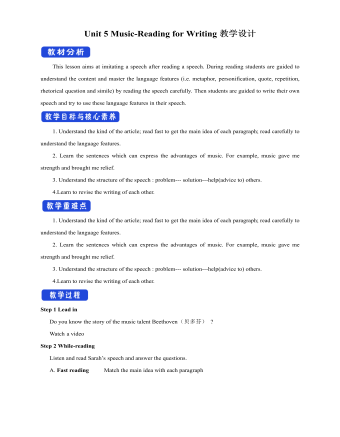
新人教版高中英语必修2Unit 5 Music-Reading for Writing教案二
The Internet celebrity Gao Yifeng. Years ago, he owned 5 companies and the staffs over 1,000, but during the economy crisis, he became nothing but debt. He was so worried that his hair became white overnight. There was a time when he wanted to killed himself. But after listening to the song Start Over by Liu Huan, he decided to cheer himself up. He started a steamed bun shop and gradually became a national chain shops. Now he became successful again.Walter Haddon said, “Music is the medicine of a troubled mind.” Music contains such a pleasant and inspiring force. Music gave him courage and bravery. When he listened to the song, it made his spirit fly like a kite in the wind. Music gave him strength and brought him relief. It was the rock I leant on to become strong and to get through those hard times. I hope none of us have to go through the same kind of suffering that he did. At the same time, we all go through various periods when we feel sad or alone. During those times, music can help us in the same way that it helped him. I hope we all will somehow begin to treasure music and make it a part of our life. Thank you for your listening !5.Revise your writing each other.Does he/she explain how music has changed his/her/someone else’s life?Are some of the rhetorical devices included and used properly ?Does he/she talk about how music makes him/her/someone feel?Is the first word in each sentences capitalised?Does he/she use correct punctuation ?
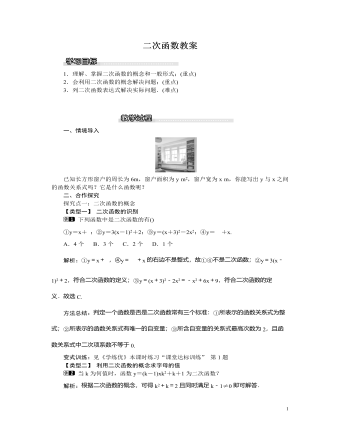
北师大初中九年级数学下册二次函数1教案
(2)由题意可得-10x2+180x+400=1120,整理得x2-18x+72=0,解得x1=6,x2=12(舍去).所以,该产品的质量档次为第6档.方法总结:解决此类问题的关键是要吃透题意,确定变量,建立函数模型.变式训练:见《学练优》本课时练习“课后巩固提升”第8题三、板书设计二次函数1.二次函数的概念2.从实际问题中抽象出二次函数解析式二次函数是一种常见的函数,应用非常广泛,它是客观地反映现实世界中变量之间的数量关系和变化规律的一种非常重要的数学模型.许多实际问题往往可以归结为二次函数加以研究.本节课是学习二次函数的第一节课,通过实例引入二次函数的概念,并学习求一些简单的实际问题中二次函数的解析式.在教学中要重视二次函数概念的形成和建构,在概念的学习过程中,让学生体验从问题出发到列二次函数解析式的过程,体验用函数思想去描述、研究变量之间变化规律的意义.
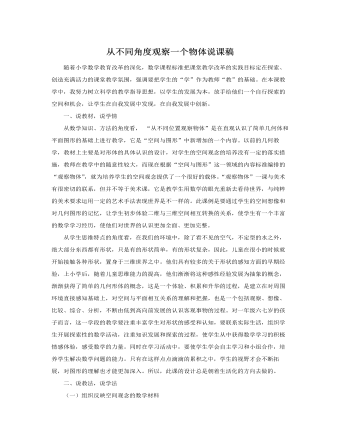
人教版新课标小学数学五年级上册从不同角度观察一个物体说课稿
(三)实践性数学是一种工具,一种将自然、社会运动现象法则化、简约化的工具。数学学习的最重要的成果就是学会建立数学模型,用以解决实际问题。因此,在这节课中,大量地创设条件,让学生把课堂中所学的知识和方法应用于生活实际之中,“学以致用”,让学生切实感受到生活中处处有数学。如上课伊始的猜冰箱,课中观察玩具、用品,给熊猫照相等,都采用了贴近学生生活的材料,旨在联系生活,开阔视野,同时延伸学习,使学生能从看到的物体的某一个面,联想到整个物体的形状,培养其观察立体实物的能力,建立初步的空间观念,发展形象思维。本课的所有教学环节都注重借助学生生活中常见的事物为知识载体,意在让学生感悟到“数学就在我们身边,生活离不开数学”。二、需进一步探究的问题“观察物体”的内容主要是对简单物体正面、侧面、上面形状的观察,因此本节课选择了大量生活中的实物让学生观察,旨在培养学生的空间观念。
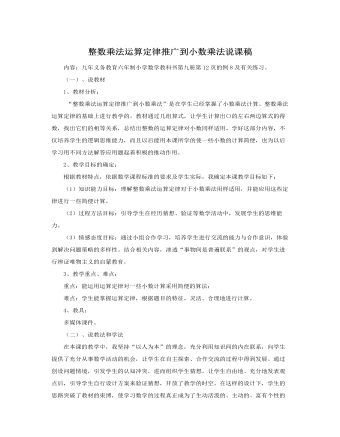
人教版新课标小学数学五年级上册整数乘法运算定律推广到小数乘法说课稿
“整数乘法运算定律推广到小数乘法”是在学生已经掌握了小数乘法计算、整数乘法运算定律的基础上进行教学的。教材通过几组算式,让学生计算出○的左右两边算式的得数,找出它们的相等关系,总结出整数的运算定律对小数同样适用。学好这部分内容,不仅培养学生的逻辑思维能力,而且以后能用本课所学的使一些小数的计算简便,也为以后学习用不同方法解答应用题起着积极的推动作用。2、教学目标的确定:根据教材特点,依据数学课程标准的要求及学生实际,我确定本课教学目标如下:(1)知识能力目标:理解整数乘法运算定律对于小数乘法用样适用,并能应用这些定律进行一些简便计算。(2)过程方法目标:引导学生在经历猜想、验证等数学活动中,发展学生的思维能力。(3)情感态度目标:通过小组合作学习,培养学生进行交流的能力与合作意识,体验到解决问题策略的多样性。结合相关内容,渗透“事物间是普遍联系”的观点,对学生进行辨证唯物主义的启蒙教育。
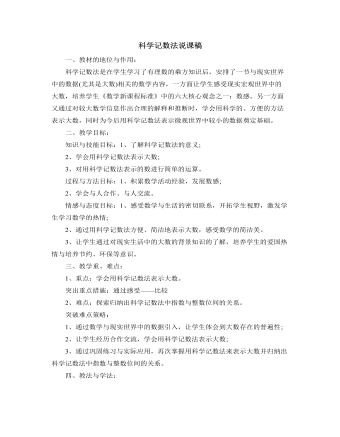
北师大初中数学七年级上册科学记数法说课稿
[设计说明]:只给出情景故事,感知了一个大数,这样还不能引起学生对大数的深刻认识,所以再给出宇宙星空中的这些大数,让学生读读、看看这些数,引起学生强烈的认知上的冲突,形成一种心理上的想读、想写的求知欲望。(二)、引出问题、探索新知在上面的例子中,我们遇到了几个很大的数,看起来、读起来、写起来都不方便,有没有简单的表示法呢?分以下步骤完成。1、回忆100 ,1000,10000,能写成10( )2、300=3×100=3×10( )3000=3×1000=3×10()30000=3×10000=3×10()3、再由学生完成上面4个例子中的数的表示。(学生对160 000 000 000这个数可能表示为、16×1010,教师要利用学生这种错误,强调a的范围)4、教师给出科学记数法表示:a×10( )(1≤a<10)。[设计说明]:通过层层递进的探究设计,启发学生成功地发现“科学记数法”的表示方法,同时又通过学生示错,让学生记住a的范围,体现了以学生为主的探究式教学。
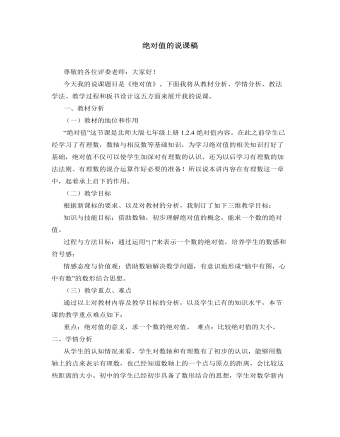
北师大初中数学七年级上册绝对值的说课稿
(三)学以致用,巩固新知为巩固本节的教学重点我再次给出三道问题: 1)绝对值是7的数有几个?各是什么?有没有绝对值是-2的数?2)绝对值是0的数有几个?各是什么? 3)绝对值小于3的整数一共有多少个?先让学生通过小组讨论得出结果,通过以上练习使学生在掌握知识的基础上达到灵活运用,形成一定的能力。(四)总结归纳,知识升华小结时我也将充分发挥学生学习的主动性,发挥教师在教学的启发引导作用,和学生一起合作把本节课所学的内容做一个小结。(五)布置作业,拓展新知布置作业不是目的,目的是使学生能够更好地掌握并运用本节课的内容。所以我会布置这样一个作业:请学生回家在父母的帮助下,找出南方和北方各三个城市的温度,并比较这些温度的大小,并写出每个温度的绝对值进行比较
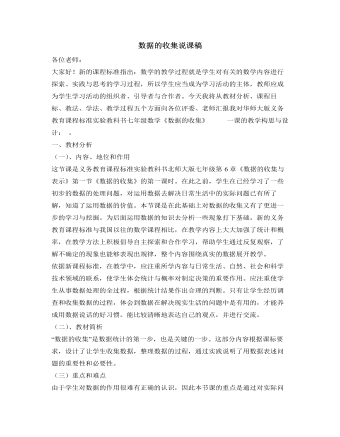
北师大初中数学七年级上册数据的收集说课稿
一、教材分析(一)、内容、地位和作用这节课是义务教育课程标准实验教科书北师大版七年级第6章《数据的收集与表示》第一节《数据的收集》的第一课时。在此之前,学生在已经学习了一些初步的数据的处理问题,对运用数据去解决日常生活中的实际问题已有所了解,知道了运用数据的价值。本节课是在此基础上对数据的收集又有了更进一步的学习与挖掘。为后面运用数据的知识去分析一些现象打下基础。新的义务教育课程标准与我国以往的数学课程相比,在教学内容上大大加强了统计和概率,在教学方法上积极倡导自主探索和合作学习,帮助学生通过反复观察,了解不确定的现象也能够表现出规律,整个内容围绕真实的数据展开教学。依据新课程标准,在教学中,应注重所学内容与日常生活、自然、社会和科学技术领域的联系,使学生体会统计与概率对制定决策的重要作用。
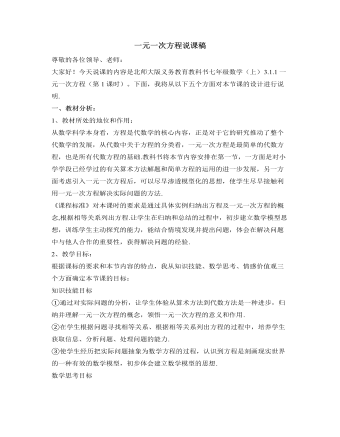
北师大初中数学七年级上册一元一次方程说课稿
五、课堂设计理念本节课着力体现以下几个方面:1、突出问题的应用意识。在各个环节的安排上都设计成一个个问题,使学生能围绕问题展开讨思考、讨论,进行学习。2、体现学生的主体意识。让学生通过列算式与列方程的比较,分别归纳出它们的特点,从而感受到从算术方法到代数方法是数学的进步;让学生通过合作交流,得出问题的不同解法;让学生对一节课的学习内容、方法、注意点等进行归纳。3、体现学生思维的层次性。教师首先引导学生尝试用算术方法解决问题,然后再引导学生列出含未知数的式了,寻找相等关系列出方程,在寻找相等关系、设未知数及作业的布置等环节中都注意了学生思维的层次性。4、渗透建模思想。把实际问题中的数量关系用方程形式表示出来,就是建立一种数学模型,教师有意识地按设未知数、列方程等步骤组织学生学习,就是培养学生由实际问题抽象出方程模型的能力。
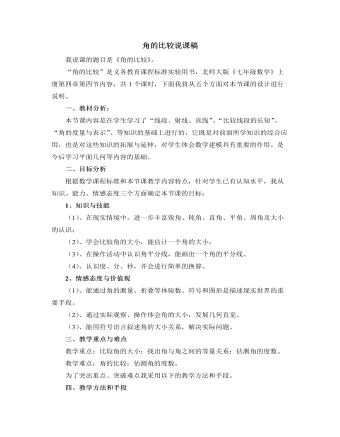
北师大初中数学七年级上册角的比较说课稿
最后我引导学生观察自己手中的量角器引导学生在测量的时候有时用度的单位还不够就必须用到比度还小的单位分和秒,进而明白度分秒之间的转换关系,并且引导学生对比和度分秒进制一样的还有时间。从而进入到例题2的讲解。接下来让学生通过随堂练习来加强和巩固本节课的内容。提高学生对本节课知识的系统综合。(四)归纳总结。小结主要由学生完成,我作出适当的补充。最后总结角的比较表方法及估测和某些角之间的等量关系的书写基本的几何语句并能根据语句画出几何图形。(五)布置作业通过作业及时了解学生学习效果,调整教学安排。使学生通过独立思考,自我评价学习效果;学会反思,发现问题;并试着通过阅读教材、查找资料或与同伴交流解决问题。
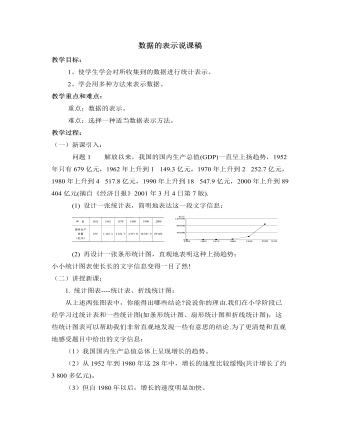
北师大初中数学七年级上册数据的表示说课稿
(1) 这28天中属于“重度染污”、“中度污染”、“轻度污染”、“良”和“优”的天数各有几天?出现的频率各是多少?请用一张统计表来表示;(3) 从你作的统计图表中,你得到哪些结论?说说你的理由.(三)课堂小结:本节课学习了用统计来直观来表示数据,并从统计图中发现数据间的联系。整理数据——制统计表1、从资料给出的许多数据中选取相关数据进行整理;2、标目分成横、纵两种(允许不同分法);3、把数据放入相应位置。为了更清晰地用统计表展示与描绘数据,统计表必须有规范的结构:标题(统计表的名称)标目(如“国家”、“届数”…)数据、必要的说明(数据的单位、制表日期等)折线统计图的步骤:(1)写出统计图名称;(2)画出横、纵两条互相垂直的数轴(有时不画箭头),分别表示两个标目的数据;(3)根据横、纵各个方向上的各对对应的标目数据画点;(4)用线段把每相邻两点连接起来。

北师大初中数学七年级上册数轴说课稿
(五)、反馈矫正,注重参与: 为巩固本节的教学重点让学生独立完成: 1、课本23页练习1、2 2、课本23页3题的(给全体学生以示范性让一个同学板书) 为向学生进一步渗透数形结合的思想让学生讨论: 3、数轴上的点P与表示有理数3的点A距离是2, (1)试确定点P表示的有理数; (2)将A向右移动2个单位到B点,点B表示的有理数是多少? (3)再由B点向左移动9个单位到C点,则C点表示的有理数是多少? 先让学生通过小组讨论得出结果,通过以上练习使学生在掌握知识的基础上达到灵活运用,形成一定的能力。 (六)、归纳小结,强化思想: 根据学生的特点,师生共同小结: 1、为了巩固本节课的教学重点提问:你知道什么是数轴吗?你会画数轴吗?这节课你学会了用什么来表示有理数? 2、数轴上,会不会有两个点表示同一个有理数?会不会有一个点表示两个不同的有理数? 让学生牢固掌握一个有理数只对应数轴上的一个点,并能说出数轴上已知点所表示的有理数。
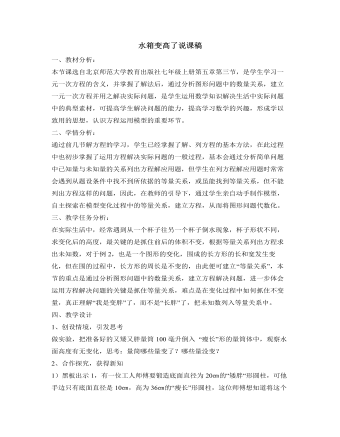
北师大初中数学七年级上册水箱变高了说课稿
一、教材分析:本节课选自北京师范大学教育出版社七年级上册第五章第三节,是学生学习一元一次方程的含义,并掌握了解法后,通过分析图形问题中的数量关系,建立一元一次方程并用之解决实际问题,是学生运用数学知识解决生活中实际问题中的典型素材,可提高学生解决问题的能力,提高学习数学的兴趣,形成学以致用的思想,认识方程运用模型的重要环节。二、学情分析:通过前几节解方程的学习,学生已经掌握了解、列方程的基本方法,在此过程中也初步掌握了运用方程解决实际问题的一般过程,基本会通过分析简单问题中已知量与未知量的关系列出方程解应用题,但学生在列方程解应用题时常常会遇到从题设条件中找不到所依据的等量关系,或虽能找到等量关系,但不能列出方程这样的问题,因此,在教师的引导下,通过学生亲自动手制作模型,自主探索在模型变化过程中的等量关系,建立方程,从而将图形问题代数化。
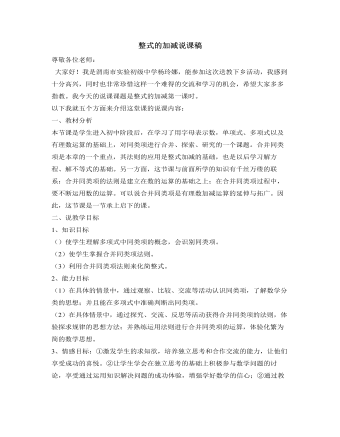
北师大初中数学七年级上册整式的加减说课稿
通过有针对性的练习,巩固所学,拓展知识,形成应用能力。本环节主要是针对学生对本节内容的掌握程度进行检测反馈。学生在经过自学、置疑、解疑、教师点拨后作一套本节的检测题。做完后,教师或学生给出答案,并给予简单解析。教师对检测成绩做以简单的统计,了解本节课的学习效果。检测题必须精心设计与安排,因为学生在做经过精心安排的检测题时,不仅在积极地掌握数学知识,而且能获得进行创造性思维的能力。要充分发挥检测题的功能,设计检测题时应由浅入深、难易适当、逐步提高、突出重点与关键、注意题型的搭配。在试题设计上,应将知识、素质、能力的考查统一起来,既有知识性、分析性题目,又有应用性、直觉形象性题目。提高创新性题型的比重和难度,少问“是什么”,多问“为什么”、“对某些问题,你以为如何”等,增强答案的发散性。
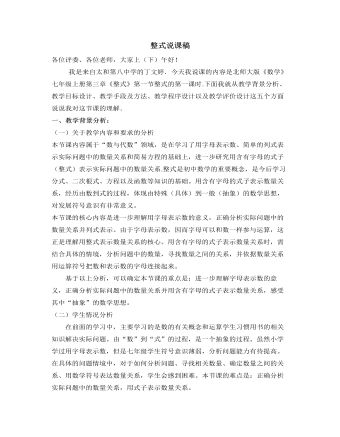
北师大初中数学七年级上册整式说课稿
按此规律,第n个式子是 。师生活动:学生通过观察,分析,归纳发现规律,并用含字母的式子表示一般结论。设计意图:进一步理解字母表示数的意义,理解用含有字母的数学式子表示实际问题中的数量关系的简洁性、必要性和一般性。(四)巩固提升问题:你能给以上这些式子赋予新的含义吗?师生活动:教师举例说明比如:如果p表示我们班的人数,我们班80%的同学喜欢上数学课,那么0.8p 就可以表示我们班喜欢数学课的人数。学生思考、交流后发言五、练习检测(1)5箱苹果重m kg,每箱重 kg ;(2)一个数比a的 倍小5,则这个数为 ;(3)全校学生总数是x,其中女生占总数52%,则女生人数是 ,男生人数是 ;(4)某校前年购买计算机 x 台,去年购买数量是前年的2倍,今年购买数量又是去年的2倍,则学校三年共购买计算机 台;(5)某班有a名学生,现把一批图书分给全班学生阅读,如果每人分4本,还缺25本,则这批图书共 本;(6)一个两位数,十位上的数字为a,个位上的数字b,则这个两位数为 .师生活动:学生板演,师生共同评价总结注意(5)带分数化假分数设计意图:进一步提高用含有字母的式子表示实际问题中的数量关系的能力。
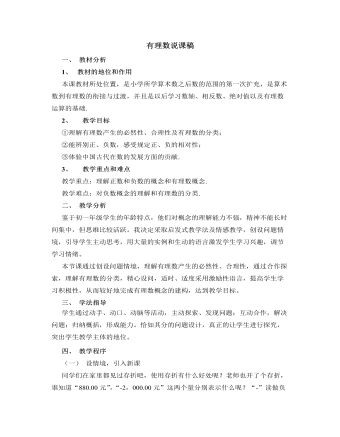
北师大初中数学七年级上册有理数说课稿
1、 教材的地位和作用本课教材所处位置,是小学所学算术数之后数的范围的第一次扩充,是算术数到有理数的衔接与过渡,并且是以后学习数轴、相反数、绝对值以及有理数运算的基础.2、 教学目标①理解有理数产生的必然性、合理性及有理数的分类;②能辨别正、负数,感受规定正、负的相对性;③体验中国古代在数的发展方面的贡献.3、 教学重点和难点教学重点:理解正数和负数的概念和有理数概念.教学难点:对负数概念的理解和有理数的分类.二、 教学分析鉴于初一年级学生的年龄特点,他们对概念的理解能力不强,精神不能长时间集中,但思维比较活跃。我决定采取启发式教学法及情感教学,创设问题情境,引导学生主动思考,用大量的实例和生动的语言激发学生学习兴趣,调节学习情绪。
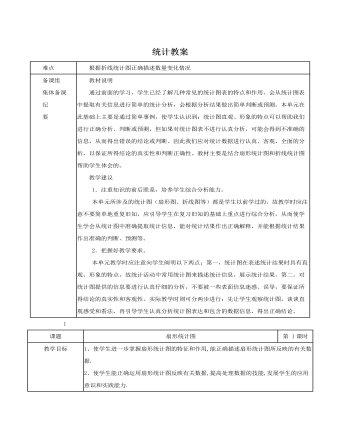
人教版新课标小学数学六年级下册统计教案
分别算出2008年比2007年各季度增产的百分数和合计数,再制成统计表.分析:根据题目要求,要算出各季度增产的百分数,我们只要根据2008年与2007年各个季度的原始数据,运用“求一个数是另一个数的百分之几”的方法就可以算出.算出了各个季度增产的百分数,根据题意制统计表时,既要按照季度分类,又要反映出年份的类别,所以在确定表头时可分为3部分:年份、台数、季度,年份又分为2007年产量、2008年产量、2008年比2007年增产的百分数.2、田力化肥厂今年第一季度生产情况如下:元月份计划生产1500吨,实际生产1620吨;二月计划生产1600吨,实际生产1680吨;三月份计划生产1640吨,实际生产1720吨,根据上面的数据,算出各月完成计划的百分数,并制成统计表.(1)制作含有百分数的统计表时,百分数这一栏一定要写清楚是谁占谁的百分之几,并按“求一个数是另一个数的百分之几”的解题方法正确算出对应百分数”
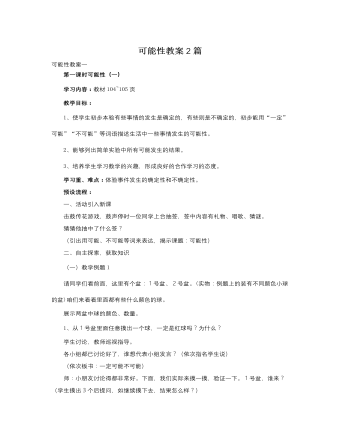
人教版新课标小学数学三年级上册可能性教案2篇
D、师:通过刚才摸球,你认为我们能摸到黄球吗?(能)一定能摸到黄球吗?(不一定)也就是说我们摸到的可能是黄球,也可能是白球。(板书:可能)3、超级竞猜:出示挂图,学生抢答。(课本105页例1)三、拓展应用1、师:在我们生活中同样有很多事情都可以用这些表示可能性的词语来表述。2、完成例2。(1)出示挂图,小组讨论。(2)组织学生汇报交流、评价,你想说哪一幅图的内容就说哪一幅。3、你还能用这些词来说说生活里的事吗?先和同桌交流,然后组织汇报、评价。4、游戏:在三叠卡片中各选一张,按排列顺序组成一句话,说一说这件事发生的可能性。5、作业:在书上完成108页第1、2题。四、总结全课1、师:今天,我们主要学习了什么内容?2、小结:生活里可能性的事情还有很多很多,有些事情一定会发生,有些事情可能会发生,有些事情不可能会发生。希望同学们做生活中的有心人,找一找生活中的可能性。

